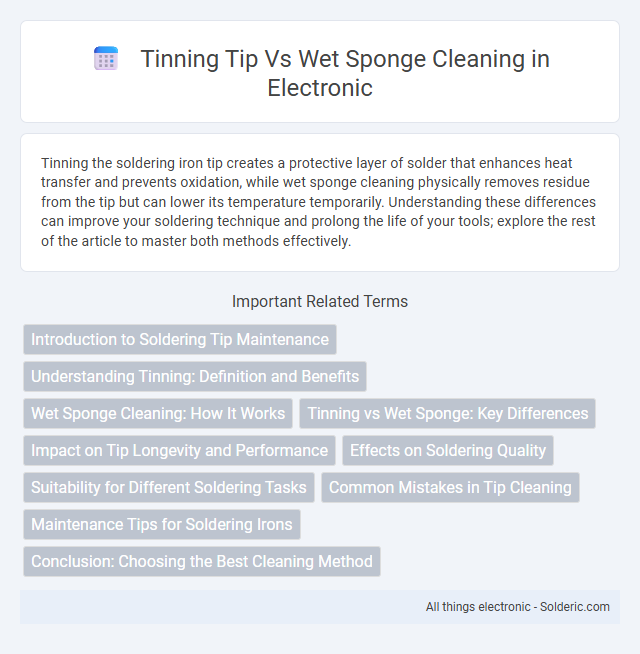Tinning the soldering iron tip creates a protective layer of solder that enhances heat transfer and prevents oxidation, while wet sponge cleaning physically removes residue from the tip but can lower its temperature temporarily. Understanding these differences can improve your soldering technique and prolong the life of your tools; explore the rest of the article to master both methods effectively.
Comparison Table
| Feature | Tinning Tip | Wet Sponge Cleaning |
|---|---|---|
| Purpose | Coats soldering tip with solder for improved heat transfer | Removes oxidation and debris from soldering tip surface |
| Method | Applying solder directly onto heated tip | Wiping tip on a damp sponge |
| Benefit | Prevents tip oxidation and maintains thermal efficiency | Keeps tip clean but may cause thermal shock |
| Impact on Tip Life | Extends tip lifespan by protecting against corrosion | Can reduce tip life due to repeated heat cycling and moisture |
| Frequency | Performed after cleaning or soldering start | Performed regularly during soldering |
| Recommended For | Maintaining tip integrity during soldering jobs | Removing surface residue during soldering |
Introduction to Soldering Tip Maintenance
Soldering tip maintenance is essential for prolonging tool life and ensuring optimal heat transfer during soldering tasks. Tinning the tip with solder helps prevent oxidation by creating a protective layer, while wet sponge cleaning removes residual flux and debris to maintain a clean surface. Regular use of both methods enhances solder joint quality and reduces the risk of tip damage.
Understanding Tinning: Definition and Benefits
Tinning involves coating the soldering iron tip with a thin layer of solder to improve heat transfer and prevent oxidation, which extends the lifespan of the tip. Wet sponge cleaning removes solder residues and flux from the tip, but frequent use can cause thermal shock and reduce tip longevity. Understanding how tinning preserves your soldering iron's performance helps you maintain optimal efficiency and precision during electronic component assembly.
Wet Sponge Cleaning: How It Works
Wet sponge cleaning works by removing oxidation and residue from the soldering iron tip, maintaining proper heat transfer for precise soldering. The moisture in the sponge rapidly cools the tip, allowing the molten solder to be wiped away and preventing tip damage. This method effectively preserves tip longevity and ensures consistent solder joints during electronic assembly.
Tinning vs Wet Sponge: Key Differences
Tinning a soldering tip involves coating it with a thin layer of solder to enhance heat transfer and prevent oxidation, while cleaning with a wet sponge physically removes solder residues and debris during use. Tinning maintains the tip's longevity and ensures consistent performance, whereas wet sponge cleaning provides immediate surface cleanliness but can cause thermal shock if used excessively. Your choice between tinning and wet sponge cleaning impacts the efficiency and durability of your soldering process.
Impact on Tip Longevity and Performance
Tinning tips regularly preserves solderability and prevents oxidation, significantly extending your soldering iron tip's lifespan and maintaining consistent heat transfer. Wet sponge cleaning can cool the tip too quickly, causing thermal shock that degrades tip coating and reduces performance over time. Using a damp brass sponge or copper wool is often recommended to balance effective cleaning with prolonged tip durability and optimal soldering results.
Effects on Soldering Quality
Tinning the tip ensures consistent heat transfer and prevents oxidation, directly improving solder joint quality by maintaining a clean, conductive surface. Wet sponge cleaning effectively removes residue, but excessive moisture can cause thermal shock, reducing tip lifespan and potentially degrading soldering precision. You can enhance soldering quality by balancing regular tinning with careful sponge cleaning to maintain optimal tip condition.
Suitability for Different Soldering Tasks
Tinning tips are ideal for soldering tasks requiring precise heat transfer and durability, such as PCB assembly and component soldering, ensuring a consistent solder bead. Wet sponge cleaning suits general-purpose soldering by effectively removing oxidation and debris from the tip, maintaining solderability without damaging sensitive components. Both methods influence solder joint quality, with tinning enhancing tip lifespan in detailed work, while wet sponges provide quick cleaning for routine usage.
Common Mistakes in Tip Cleaning
Common mistakes in tinning tip versus wet sponge cleaning include overheating the soldering tip during tinning, which can degrade the tip's protective coating and reduce lifespan. Using a wet sponge can cause thermal shock, leading to tip damage if the tip isn't properly heated beforehand. Failure to regularly remove oxidation through proper tip maintenance results in poor heat transfer and compromised solder joints.
Maintenance Tips for Soldering Irons
Tinning the tip of your soldering iron prevents oxidation and extends its lifespan by creating a protective layer of solder. Using a wet sponge to clean the tip removes excess solder and debris, ensuring precise heat transfer and stable solder joints. Regularly combining tinning with gentle cleaning on a moist sponge maintains optimal soldering performance and prevents tip damage.
Conclusion: Choosing the Best Cleaning Method
Tinning tips maintains solderability by coating soldering iron tips with a protective layer, thereby preventing oxidation and extending tip lifespan. Wet sponge cleaning effectively removes solder residues and contaminants during soldering, ensuring a clean working surface and precise connections. Your choice depends on balancing longevity and cleanliness, with tinning suited for tip care and wet sponges ideal for real-time cleaning.
Tinning tip vs wet sponge cleaning Infographic

 solderic.com
solderic.com